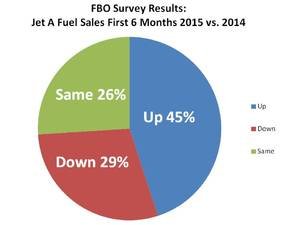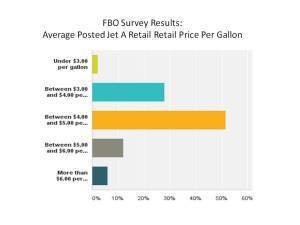Mid-Year FBO Fuel Sales Survey: 71 Percent of Respondents Report Increased or Flat Fuel Sales
/By John L. Enticknap and Ron R. Jackson, Principals, Aviation Business Strategies Group
Following our Annual FBO Fuel Sales Survey, we initiated our first Mid-Year Fuel Sales Survey. Please note this is a top-line survey designed only to gauge trends. The survey database was provided by AC-U-KWIK.
As a quick review, the annual survey results we released in January indicated that 49 percent of FBOs surveyed reported an increase in Jet A fuel sales in 2014 compared to the results of 2013 while 18 percent reported fuel sales to be about the same. This gives a total of 67 percent reporting having at least the same fuel sales or improved fuel sales over 2013. (For complete results of our annual survey, please click here.)
As part of this mid-year survey, we asked:
For the first six months of 2015, compared to the same period in 2014, are your Jet A fuel sales:
- Up from a year ago?
- Down from a year ago?
- About the same?
A total of 45 percent of the FBOs responding to the survey reported sales were up from a year ago with 26 percent indicating sales were about the same. That’s a total of 71 percent reporting having at least the same fuel sales or improved fuel sales from a year ago.
Conversely, 29 percent indicated Jet A fuel sales were down in 2015 compared to the same first six months of 2014.
For this mid-year survey, we also wanted to get a feel for the average posted Jet A retail price so we asked:
What has been your average posted retail price per gallon of Jet A over the past six months? Respondents were given a choice of price ranges with the following responses:
- 2 percent reported their posted Jet A price was under $3.00 per gallon.
- 28 percent between $3.00 and $4.00 per gallon.
- 52 percent between $4.00 and $5.00 per gallon.
- 12 percent between $5.00 and $6.00 per gallon.
- 6 percent indicated more than $6.00 per gallon.
As we all know, because of various industry discount programs, the majority of FBOs do not sell Jet A fuel at the posted retail price. However, the results of this survey question can provide insight into what FBOs are posting on average.
Further, it has been our experience in consulting with many FBOs as well as conducting the NATA FBO Success Seminar, that the average margin on Jet A fuel sales runs between $1.30 and $1.60 per gallon. FBOs that are consistently selling Jet A Fuel below a margin $1.10 are having a hard time of making ends meet.
For our next blog post, we’ll draw some conclusions and take a look at the responses we received from our write-in question:
What has been your biggest challenge so far in 2015? Some of the answers may surprise you.
About the bloggers:
John Enticknap has more than 35 years of aviation fueling and FBO services industry experience. Ron Jackson is co-founder of Aviation Business Strategies Group and president of The Jackson Group, a PR agency specializing in FBO marketing and customer service training. Visit the biography page or absggroup.com for more background.
Subscribe:
FBO Tip of the Week: The Key Elements to Pricing Fuel
/By John L. Enticknap and Ron R. Jackson
Aviation Business Strategies Group
As we have all seen, the cost of Jet A fuel on the world markets started to fall more than 10 months ago and hit the lowest point in January. Since then, the price has been inching up.
By keeping an eye on the fuel market, FBOs can avoid falling short of their profit goals. As we know, the base price for a gallon of Jet A was as low as $1.48 a few months ago. With a Platts price of around $1.90 today, FBOs are paying approximately 42 cents per gallon more, which means an average load of fuel has gone up $3,500.
Because fuel sales drive FBO profitability, it’s imperative we keep a constant vigil on the key elements to pricing our fuel:
- A consistent review of posted prices in your market.
- Tracking your cost of fuel load-by-load and knowing what's in your tank.
- Calculating the true cost to pump that fuel.
- A realistic review of your contract fuel.
At our most recent NATA FBO Success Seminar in March, we forecast that the price of oil was poised for a relatively steady recovery following the recent collapse to under $50 per barrel. Based on market intelligence, including a report by the International Energy Agency (IEA), the recovery will not come close to returning to the highs of past years. In the IEA report, the Paris-based organization of 29 major oil importing nations said the fuel price rebound “will be comparatively limited in scope, with prices stabilizing at levels higher than recent lows but substantially below the highs of the last three years.”
With the continued volatility of Jet A fuel markets, FBOs need to conduct fuel surveys. Many online fuel pricing resources, such as those posted by AC-U-KWIK and others, provide relative survey data that is generally very good for benchmarking the marketplace. With these resources you get instant feedback on the range of pricing in your area plus the average price.
With this type of information, you can complete a simple price formula calculation. For example:
Base Price (Platts or Spot Jet A Price): $1.90
Supplier differential: $0.15
Transportation: $0.10
Fed & State Taxes: $0.337
Flowage Fee: $0.09
Total Cost of Fuel: $2.577
Plus Gross Profit Projected: 2.25
Calculated Retail Price: $4.83
Jet A
$3.30-$7.52
average $4.86
In this example, the projected posted price is just about average. For an FBO that has recently invested in new infrastructure and employee enrichment, such as a new hangar and customer service training, a realistic Jet A posted retail price could easily be $4.98. Now you can start your discounts from there.
However, as we counsel our FBO clients, don’t give away all your services. Every customer who comes on your ramp must contribute to your revenue stream in some way, especially the reluctant customer that doesn’t buy fuel.
Therefore, keep your costs in mind. Knowing your costs to pump fuel is key. With this knowledge you can apply your margin/into plane fee to the contract providers price. Then your business will be lean, mean and profitable!
Give us your feedback; we always like to hear your comments and read our eBook; “FBO Survival, Keep Your Operation Lean Mean & Profitable.”
About the bloggers:
John Enticknap has more than 35 years of aviation fueling and FBO services industry experience. Ron Jackson is co-founder of Aviation Business Strategies Group and president of The Jackson Group, a PR agency specializing in FBO marketing and customer service training. Visit the biography page or absggroup.com for more background.




